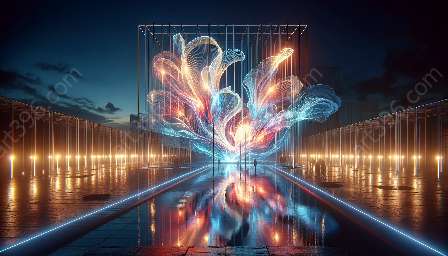Light has always been a source of fascination for humans, shaping our perception of beauty and aesthetics. From ancient cave paintings to modern light art installations, the interplay between light and human emotion has been central to artistic expression. Understanding the psychology of light in art and its impact on our sense of beauty provides deep insights into the human experience.
The Psychology of Light in Art
Light is a fundamental element in art, influencing the way we interpret and experience visual stimuli. The psychology of light in art explores how the use of light affects human perception, emotion, and cognition. Artists throughout history have used light to create moods, evoke emotions, and convey meaning. The interplay of light and shadow can create depth, drama, and atmosphere, shaping the viewer's psychological response to the artwork.
Human Sense of Beauty and Aesthetics
Human beings have an innate appreciation for the aesthetic qualities of light. Whether it's the warm glow of a sunrise, the interplay of light on water, or the mesmerizing patterns of light in a modern installation, light holds a unique appeal for our sense of beauty. The way light interacts with colors, textures, and forms can evoke a profound emotional and aesthetic response, shaping our perception of the world around us.
Light Art
Light art represents a fusion of technology, creativity, and human perception. Artists harness the properties of light to create immersive, multi-sensory experiences that challenge traditional artistic boundaries. Whether through projection mapping, interactive light displays, or neon sculptures, light art captivates and engages viewers in new and unexpected ways. It blurs the line between the tangible and the ethereal, inviting us to explore the interplay between light, space, and our own experiences.
The Interconnection
The relationship between light art, human sense of beauty, and aesthetics is deeply intertwined with our emotional and cognitive responses. As we engage with light art, we become active participants in the creation of meaning, drawing on our own unique perceptions and sensibilities. Light art invites us to reconsider our notions of beauty, challenge our preconceptions, and experience the world in a different light.
The Emotional Impact of Light Art
Light art has a profound emotional impact on viewers, eliciting a wide range of feelings such as wonder, awe, tranquility, and excitement. These emotional responses are deeply connected to the aesthetic experience, shaping our understanding of beauty and our place in the world. Whether through the play of colors, the manipulation of light and shadow, or the use of innovative technology, light art transcends traditional artistic boundaries and opens new avenues for exploring human emotion and perception.
Conclusion
The exploration of light art, the human sense of beauty, and aesthetics offers a rich tapestry of interconnected ideas and experiences. Through understanding the psychology of light in art and the emotional impact of light art, we gain deeper insights into the complex relationship between light, human perception, and the cultivation of beauty. As we continue to engage with light as a medium of artistic expression, we embark on a journey of discovery, reflection, and appreciation for the symbiotic nature of light and human experience.

